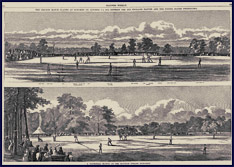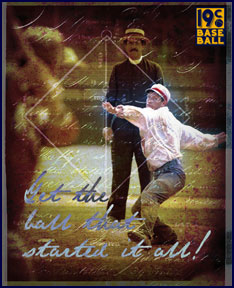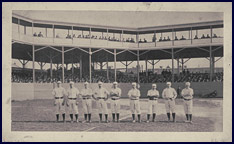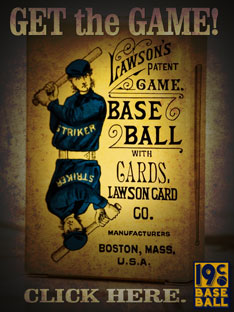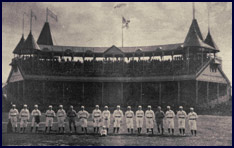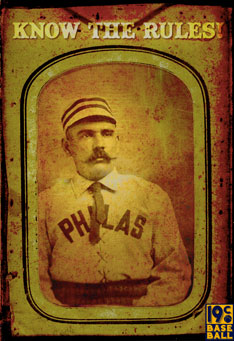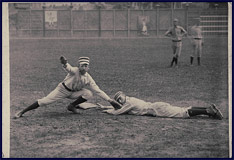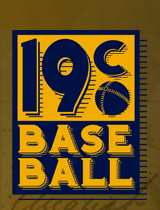The Batter's Area and Position
(Pre-1856 to 1873) Continued
trikes were allowed to be called by the umpire starting with the 1858 season, to help alleviate the batter taking numerous pitches to either allow the runner(s) to advance by stealing or tire the pitcher. The above rule attempted to restrict the batter's movement by making him start on his turn at bat with one foot on the striker's line. The rule, as written, does not state that the striker had to stand on the line when hitting the ball or which foot has to be on the line. Strikers, when facing faster pitching, would place their back foot on the line and then step back, moving their back foot back, toward the catcher, before the pitch was thrown. They would drive the ball down into foul territory, attempting to tire the pitchers. Pitcher's then began to throw the ball off the plate in an attempt to have the batter's "chase" pitches. Beginning with the 1863 season, the rule allowing the umpire to call unfair pitches balls, was instituted.
Henry Chadwick, baseballs most influential and popular writer, included his interpretation and description in Beadle's Dime Base Ball Player 1860-1862 and 1864. There was no Beadle's printed for the 1863 season.
Note: The line referred to, in the above rule, is one parallel to a line extending from the first to the third base. The striker should keep one foot on this line; as, if he stands back of the base, a ball striking the ground perpendicularly from his bat, will be considered a fair ball-if the umpire strictly enforces the rule-though it actually strikes the ground behind the home base. If this rule be not strictly enforced, many a ball that ought to be a fair one will be declared foul.
It is important to note that Chadwick was not a fan of the "fair-foul hit" and seemed to oppose many changes implemented to improve the game. A fair -foul hit was accomplished when the batter struck a pitched ball directly to the ground, hitting first in fair territory and then immediately carrying into foul territory. This practice was abolished for the start of the 1877 season.
Chadwick's interpretation and descriptions were changed for the 1865 Beadle's Dime Base Ball Player guide and were stated as follows:
This rule should be strictly enforced by the umpire. A striker has no right to avail himself of the advantage derived from standing back of the line of his position, thereby increasing the distance between himself and the pitcher and obtaining a better opportunity of judging the ball. Besides which, a poorly hit ball which would strike the ground in front of the home base-if the batsman stood on the line of his base-and lead to his being put out, is changed to a foul ball by his standing back of his base, and he thereby escapes the penalty of his poor batting.
Chadwick recognized that that the batters are still fouling off pitches to tire the pitcher and it was hindering the game. He also did not want to see the batters hit from behind the 3' line (right-handed batter with his left foot behind the line and a left-handed batter with his right foot behind the line). Batters were still moving during their time at bat.
The batting rule listed in the 1867 Beadle's Dime Base Ball Player guide was modified read as follows:
"The striker, when in the act of striking, shall not step forward or backward, but must stand on a line drawn through the center of the home base, not exceeding in length three feet from either side thereof, and parallel with the line occupied by the pitcher."
The batter was allowed to move as the ball was pitched but when he started his swing, "in the act of striking," he was required to have one foot on the batter's line. If he had his front foot on the batter's line he was not allowed to "take a step back," with the front foot, to increase the distance from him and the pitcher and drive the ball into the ground in foul territory. If he had his back foot on the line, he was not allowed to "take a step forward," with the back foot, to shorten the distance to the pitcher and drive into the field of play.
Home Base was changed to a 12 inch square flat plate for the 1868 season and it was still required to be painted white. The center of the newly shaped base was also placed on the intersection of the third and first base line foul lines and one corner of the base faced the pitcher and the opposite the catcher.
The batting rule listed in the 1868 Beadle's Dime Base Ball Player guide was changed again and stated:
"The striker, when about to strike the ball, must stand astride of a line drawn through the center of the home base, not exceeding three feet from either side thereof, and parallel with the front line of the pitcher's position, and he must not take any backward step when striking at the ball. The penalty for an infringement of this rule shall be the calling of one strike; and when three such strikes have been called, the striker shall be declared out."
The batting rule was modified for the 1869 season and read as follows in Beadle's Dime Base Ball Player guide:
"The striker, when in the act of striking at the ball, must stand astride of a line drawn through the center of the home base, not exceeding three feet from either side thereof, and parallel with the front line of the pitcher's position, and he must not take any backward step when striking at the ball. The penalty for an infringement of this rule shall be the calling of foul strike; and when three such strikes have been called, the striker shall be declared out."
De Witt's Base Ball Guide for 1869 narrative firmly explains the rule:
"The batsman is now required, 'when in the act of striking at the ball' to stand astride the line of home base. Last season the words were, 'when about to strike the ball.' The wording was found to be too indefinite, and hence the change. Now the batsman, at the same time that he is required to stand astride the line of the home base when he strikes at the ball, is not cramped in his movements, for he can still take a step forward - but not backward - provided, that in doing so he still strides the line of the home base."
NOTE: Beginning with the 1870 season the first pitched ball to the batter was not counted. Neither the batter nor the pitcher received a warning before a strike or ball was called. In 1874, every third "unfair" pitch was called a ball, technically allowing the pitcher to throw nine unfair pitches to give the batter his base on balls.
